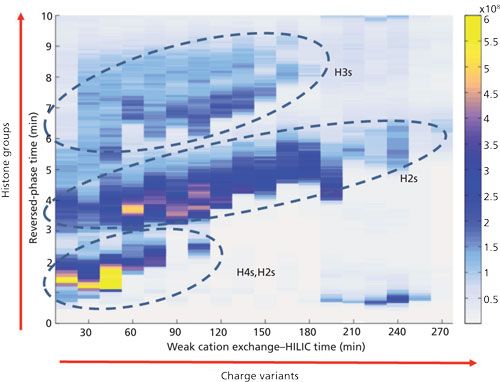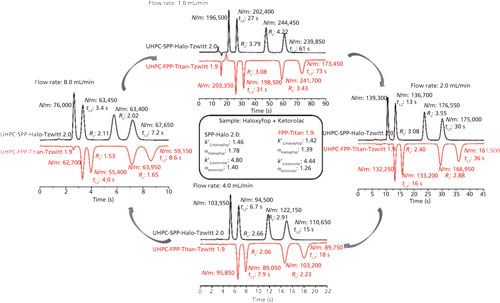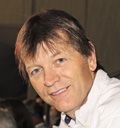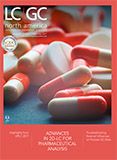Highlights from HPLC 2017 Symposium
LCGC North America
Topics that stood out at HPLC 2017 include advances in large-molecule separations, multidimensional chromatography, HILIC, and chiral separations.
The 45th International Symposium on High Performance Liquid Phase Separations and Related Techniques (HPLC 2017), cochaired by Michal Holcapek and František Foret, was held June 18–22 in Prague, Czech Republic. This installment covers some of the highlights observed at the symposium, including advances in large-molecule separations, multidimensional chromatography, and areas of growing application of high performance liquid chromatography (HPLC). In addition, trends and perspectives on future developments in HPLC noted from the conference are presented.
The 45th International Symposium on High Performance Liquid Phase Separations and Related Techniques, or HPLC 2017, convened for the first time in Prague, Czech Republic. The conference was held June 18–22 at the Prague Conference Center. The HPLC conference, which has grown into the premier event bringing together leading scientists in the field of liquid chromatography and related techniques, attracted more than 1350 delegates from numerous countries. Statistics from the conference may be viewed at www.hplc2017-prague.org/. The attendance was a considerable increase compared to recent HPLC conferences, perhaps because of the draw of such a beautiful city. The well-organized conference was chaired by Michal Holcapek of the University of Pardubice and František Foret of the Institute of Analytical Chemistry, The Czech Academy of Sciences. As noted by the chairs, the symposium brings leading researchers from around the world to discuss many aspects of liquid separations.
One objective of the symposium was to engage young researchers through a dedicated program track that featured tutorials from well-known experts in the field as well as speaking opportunities for young scientists. A complete program track was also devoted to hyphenated techniques because of the importance of mass spectrometry (MS) in all fields of separation.
The conference included nearly 300 oral presentations including several plenary lectures and more than 650 poster presentations. There were also several short courses, vendor seminars, and tutorials within the program. This installment of “Column Watch” reports on observed highlights and trends from the conference.
Highlights and Trends
In a similar fashion to the 2016 HPLC review article (1), several colleagues present at the symposium were asked for their insight regarding the most interesting topics they observed at the event. Much of what follows is a synopsis of their responses along with some personal views.
In reviewing highlights from the 2016 symposium, several areas of interest stood out, namely three-dimensional (3D) printing, advances in large-molecule separations, multidimensional separations, and hydrophilic-interaction chromatography (HILIC). With the exception of 3D printing, each of these areas were again frequent topics of discussion at HPLC 2017. In a search of the program for terms such as “3D” and “three dimensional,” only a handful of hits were returned. In Brett Paull’s presentation, entitled “Another 12 Months Closer to 3D Printed HPLC Columns,” he noted continued progress toward the goal, but that there is still a ways to go before 3D columns are commercially viable (2). Several other posters and presentations noted the value of 3D printing for microfluidic devices. The use of 3D technologies to support liquid separations continues to be a topic of interest; however, true 3D printing of high performance liquid chromatography (HPLC) columns still appears to require considerable research. In addition to the aforementioned hot topics of interest, two other areas were noted at the 2017 symposium: developments and fundamentals in chiral chromatography and adaptation of modern techniques in the industry. What follows are some highlights from each of these topics.
Advances in Large-Molecule Separations
The characterization of large molecules requires a number of different chromatographic techniques including reversed-phase chromatography, ion-exchange chromatography, size-exclusion chromatography (SEC), and hydrophobic interaction chromatography (HIC). There were a number of presentations dealing with different aspects of large-molecule separations throughout the conference. In one presentation of note, Sebastiaan Eeltink provided a general overview of HIC and discussed the relationship between salt concentration and analyte retention (3). HIC makes use of the interactions between hydrophobic regions of the protein with weakly hydrophobic ligands attached to the stationary phase where retention is governed by the concentration of salt in the mobile phase. Eeltink discussed the use of chaotropic and kosmotropic salts and their impact on protein retention. He concluded that the effects are complex but that linear response of retention to salt concentration can be used for effective method development. More information on this topic from the Eeltink group can be found in a recent paper (4).
Separation of large molecules continues to take advantage of modern developments in particle technologies. As an example, Mark Schure presented a talk entitled “Size Exclusion Chromatography with Superficially Porous Particles,” where he noted that efficiency gains, and thus the potential for speed, in SEC can result from the use of superficially porous particle (SPP) architecture (5). Theory dictates that a large pore volume is necessary to gain maximum performance in SEC because of its inherent low peak capacity. Schure demonstrated that even though SPPs exhibit a lower pore volume than the fully porous particles (FPPs) that are typically applied to SEC, the shorter diffusion path associated with the former can lead to more efficient and, thus, faster SEC separations. Further details can be found in reference (6).
Multidimensional Separations
The topic of multidimensional separations has been a consistent focus at recent HPLC meetings. The trend continued with the 2017 event. The oral session entitled “Multi-Dimensional Separations” was the third highest attended session at the conference according to the website statistics. A search through the program revealed that multidimensional separations are being applied in areas such as antibody–drug conjugates (ADCs), monoclonal antibodies (mAbs), complex peptide separations, and several “omics” areas of interest. Fundamental studies including orthogonality assessments, introduction of modulation from the first dimension to the second, and improving detection sensitivity were all discussed during the conference. One notable talk was given by Andrea Gargano in which he discussed the intact protein analysis of HeLa core histones by multidimensional LC (7). Gargano first noted that weak cation exchange–HILIC analysis in a single dimension is highly selective for histone charge variants. However, the method required high acid concentration to ensure the complete elution of the analytes, significantly limiting the MS sensitivity. He also noted that reversed-phase chromatography is compatible with MS, but the selectivity of this mode is limited to class separation. Gargano went on to demonstrate that the online coupling of the two dimensions combines the advantage of both separations. When coupling his separation platform with high-resolution mass spectrometry and ultraviolet photodissociation (UVPD) MS/MS, he could significantly increase the degree of proteoform characterization. A representation of what is possible using this technique is presented in Figure 1.
Figure 1: 2D chromatogram of total ion current of a weak cation exchange-HILICxreversed-phase LC UVPD-HRMS analysis of HeLa core histones. The 2D LC separation combines the charge resolving power from the weak cation exchange separation with the histone family group separation (H2, 3, 4) given by reversed-phase LC. Adapted with permission from reference 7.

It was also noted in last year’s highlights that multidimensional chromatography is gaining acceptance for industrial applications and that ion mobility coupled to mass spectrometry (IM-MS) may be an alternative or potentially used in addition to multidimensional liquid separations. Both trends continued into 2017. (See sections following for more discussion on industrial applications.)
Research associated with the use of ion mobility spectrometry (IMS) as a supplementary separation technique to one-dimensional (1D)-LC or two-dimensional (2D)-LC separation continues to surface. One noted presentation on the topic of IMS was presented by Tim Causon (8). The major points in Causon’s presentation were focused on the fundamentals of low-field drift tube ion mobility-mass spectrometry (DTIM-MS) where he described the separation power as peak capacity, in a similar fashion to liquid phase separations. Causon highlighted that the reproducibility of new DTIM-MS instrumentation is extremely good (<0.3% interday precision), which allows one to use a powerful combination of retention time, high-resolution MS (time of flight [TOF]-MS), and a collision cross section (CCS) from the DTIM-MS separation as identification points for each compound. With confidence in CCS reproducibility, the Causon group is currently using this approach for various metabolomics applications including the nontargeted analysis of wine where the CCS values are proving useful. More information can be found in recent publications from the Causon group (9,10). There have been many improvements in ion mobility analyzers over the past decade that may continue to stimulate additional growth of the technique within the separation science community.
Hydrophilic Interaction Chromatography
HILIC was once again a highly discussed topic at the HPLC meeting. In a search of the conference proceedings, 47 separate talks, tutorials, and posters were observed relating to developments and applications in HILIC. Topics included the use of HILIC in multidimensional chromatography, method development strategies, and applications in areas such as peptides, glycosylation studies, and reduction of matrix effects. Fundamentals of HILIC with respect to retention mechanisms, equilibrium dynamics, and selectivity were also featured. Valentina D’Atri, in her presentation entitled “HILIC-MS: A Powerful Analytical Tool for the Profiling of Glycosylation Patterns of Biopharmaceutical Proteins at the Middle-Up Level,” noted that the main benefit of HILIC was the separation of glycovariants at the protein level (11). This separation has not been achieved using other standard chromatographic modes. It will be interesting to observe how HILIC, which has been primarily applied to polar small molecules, applies within the large-molecule arena. Another noted highlight related to HILIC was a tutorial presented by Andrew Alpert pertaining to the effect of salts on the retention of neutral solutes in HILIC (12). His investigations on chaotropic and kosmotropic salts and their effect on retention demonstrated that we are still very far away from a firm mechanistic understanding of HILIC and that much more work in this field is needed.
Chiral Separations
Presentations discussing many aspects of chiral chromatography were abundant at this year’s conference. More than 50 posters and presentations provided information about fundamentals, method development and optimization techniques, novel stationary-phase developments, and applications using HPLC, 2D-LC, supercritical fluid chromatography (SFC), and capillary electrophoresis (CE). Some of the featured application areas centered around amino acids, herbicides, pesticides, fungicides, drug metabolites, and drugs of abuse-to name a few. An interesting note is the development of chiral stationary phases on modern particle technologies. In his plenary lecture, Alberto Cavazzini presented a comprehensive thermodynamic and kinetic evaluation of chiral stationary phases (CSPs) built on modern FPPs versus SPPs (13). Methods and the fundamental foundations for the determination of the different contributions to mass transfer were presented in detail. Cavazzini concluded from his studies that CSPs built on SPPs outperformed those using FPPs for both the longitudinal diffusion (B term) and portions of the mass transfer terms (C term) of the van Deemter equation. He also noted that the effect of the eddy diffusion (A term) and contributions to adsorption in the mass transfer term are dependent on the chiral selector and silica support properties. Cavazzini went on to mention that the effect of bonding density and the nature of the chiral selector as well as the impact of the surface chemistry are areas requiring further investigation. In a similar study, entitled “From Sub 2-Micron Fully Porous Teicoplanin-Based Zwitterionic Chiral Stationary Phases to 2-Micron Superficially Porous Ones: What Can We Expect in Terms of Efficiency Gain?” presented by Michela De Martino, it was determined that 2-µm SPP phases outperformed sub-2-µm FPP phases of the same ligand chemistry (14). Using a novel teicoplanin-based chemistry, 2.6-µm and 2.0-µm SPP phases were compared to a 1.9-µm FPP column. The high performance of the 2.0-µm SPP phase allowed for “ultrahigh-speed” chiral separations as shown in Figure 2.
Figure 2: Ultrafast separations of rac-haloxyfop and rac-ketorolac on 2-cm-long columns: UHPC-SPP-Halo-Tzwitt 2.0 (black traces) and UHPC-FPP-Titan-Tzwitt 1.9 (red traces) at flow rates ranging from 1.0 to 8.0 mL/min. Eluent: 85:15 acetonitrile–water + 20 mM ammonium formate; temperature: 35 °C. Adapted with permission from reference 14.

Further evidence of interest in fundamental studies involving chiral phases was provided in a talk by Attila Felinger titled “Mass Transfer Properties of Zwitterionic Chiral Stationary Phases” (15). Felinger’s work focused on the investigation of mass transfer phenomena in a zwitterionic chiral stationary phase (CSP) based on a cinchona alkaloid chiral selector. The efficiency of the zwitterionic column was measured as a function of temperature. By combining experimental measurements (for the determination of effective diffusion coefficients) with a model of diffusion in porous media, Felinger evaluated the different contributions to band broadening. Interestingly, it was determined that adsorption-desorption kinetics dramatically affect the efficiency of the second eluted enantiomer. In addition, through the microscopic-probabilistic model of chromatography, some important thermodynamic information on the heterogeneous character of the adsorption-desorption process was obtained. The work is particularly interesting because it combines a macroscopic and a molecular description of the chromatographic process in the field of chiral chromatography where there is a strong need for a model describing the fundamentals of mass transfer processes.
Adaptation of Modern Techniques in Industry
As was noted in the 2016 HPLC highlights column (1), pharmaceutical companies and other industrial sectors are embracing many of the modern developments in separation science to address the challenges of separating impurities and peak purity profiling. Kelly Zhang outlined a novel platform called mLC–nLC, in which a primary column is chosen for a first dimension analysis from a preliminary screen (16). After the first dimension column is chosen the sample is sent, via multi-heart-cutting, to multiple additional columns in the second dimension. Advanced software is used to vary and select the best second dimension analysis conditions, but also to vary the second dimension detection technique. Zhang’s point, that “rapid analysis” could mean “rapid method development” for many users, was interesting.
As an additional example of the utility of modern techniques in industry, Stefan Lamotte outlined a one-time analysis plan that is used when multidimensional analysis is not practical (17). Lamotte described the use of a set of serial columns that may contain the same or orthogonal stationary phases. These columns contain 5-µm SPPs to take advantage of the low pressures provided by the particle size, but also the efficiency increase benefit provided by the SPP architecture. The process involves injecting the complex sample through multiple columns linked serially and, in some cases, repeating the process back through columns a second or third time in a technique Lamotte termed peak recycling chromatography, generating very high plate counts. Although the process does come at the expense of time, the analysis is usually only required once and is therefore not prohibitive.
It is evident from these and other presentations at the conference that advances in separation science are providing real-world solutions. Multidimensional separations, modern particle technologies, and novel approaches for their use will likely continue to grow within industry, especially for complex separations.
Session Highlights
Plenary Sessions
The plenary sessions were acknowledged as another significant highlight from the conference. Peter Willis’s lecture, entitled “Searching for Life on Ocean Worlds with Liquid Chromatography,” was captivating (18). Willis described the use of separation technologies in space missions to look for evidence of life. The exploration of the boundaries of separation science utility and ruggedness are exciting directions that are seldom discussed. In a similar vein, Zoltan Takats presented a talk within the plenary session where he discussed the use of LC–MS and ambient lipodomic profiling for cancer diagnostics (19). Takats discussed the use of the “intelligent knife,” or iKnife, that can tell surgeons immediately whether the tissue they are cutting is cancerous or not. These developments represent a tangible revolution in the medical sciences. It’s easy to envision such devices in the future that could also be applied in other important fields such as food safety, for example.
Session Devoted to the Memory of Jack Kirkland
A certain highlight of the conference was a session dedicated to the memory of Jack Kirkland, who passed away in October 2016. The session opened with a dedication from one of Jack’s longtime friends and colleagues, Joe DeStefano. DeStefano described Jack as a true pioneer for HPLC, noting that Jack built his first instrument himself. Jack’s designs were then used by DuPont to build one of the first commercially available HPLC instruments. Figure 3 shows Kirkland in front of an early model HPLC system. DeStefano went on to discuss many of Jack’s groundbreaking contributions to particle technologies through the years. DeStefano stressed that Jack was also a great teacher of separation science. Jack published many books, and he developed, as well as taught, American Chemical Society courses on separation science.
Figure 3: Jack Kirkland in front of an early model HPLC system. Photo provided by Dr. Joseph DeStefano.

The “YOU Track”
Several colleagues noted the “YOU track” as a certain highlight. As mentioned in the introduction, one objective of the symposium was to engage young researchers through a dedicated program track that featured tutorials from well-known experts in the field as well as speaking opportunities for young scientists. The lectures presented by these young scientists were highly regarded by many. To one colleague, the “Metabolomics and Lipidomics” session was of particular interest. It is anticipated that the success of this special track will foster similar sessions at future HPLC symposia.
Poster Sessions
Poster sessions are an important part of any HPLC symposium. The 2017 event was no exception with more than 650 posters presented. The sessions were once again lively with many discussions in all areas of separation science.
Conclusions
HPLC 2017 was an extremely well-organized and eventful symposium bringing together researchers interested in separation science from around the globe. Many of the trends noted in 2016 continue to be the focus of today’s research. From recent advances in understanding separation fundamentals to the application of technologies for difficult applications, researchers in the separations sciences continue to successfully tackle many of the worlds’ challenging issues.
Acknowledgments
Coverage of such a large symposium is impossible without a great amount of assistance. The author would like to acknowledge the invaluable assistance from Dr. Andrew Alpert, Professor Attila Felinger, Professor David McCalley, Professor Deirdre Cabooter, Professor Robert Kennedy, Mr. Ty Kahler, Professor Alberto Cavazzini, Professor Michael Wittig, Professor Ken Broekhoven, Dr. Tim Causon, Dr. Joe DeStefano, Dr. Andrea Gargano, Dr. Mariosimone Zoccali, Dr. Omar Ismail, and Professor Francesco Gasparrini for providing notes, text, insights, figures, and fruitful discussions regarding the content of various sessions.
References
- D.S. Bell, LCGC North Am.34(9), 700–709 (2016).
- V. Gupta, N. MacDonald, S. Currivan, P. Nesterenko, and B. Paull, “Another 12 Months Closer to 3D Printed HPLC Columns,” presented at 45th International Symposium on High Performance Liquid Phase Separations and Related Techniques (HPLC 2017), Prague, Czech Republic, 2017.
- S. Eeltink, “Advancing Native Protein Separations by Size Exclusion and Hydrophobic Interaction Chromatography,” presented at 45th International Symposium on High Performance Liquid Phase Separations and Related Techniques (HPLC 2017), Prague, Czech Republic, 2017.
- M. Baca, J. De Vos, G. Bruylants, K. Bartik, X. Liu, K. Cook, and S. Eeltink, J. Chromatogr. B1032, 182–188 (2016).
- M. Schure, R. Moran, S. Schuster, B. Wagner, and C. Juo, “Size Exclusion Chromatography with Superficially Porous Particles,” presented at 45th International Symposium on High Performance Liquid Phase Separations and Related Techniques (HPLC 2017), Prague, Czech Republic, 2017.
- M.R. Schure and R.E. Moran, J. Chromatogr. A1480, 11–19 (2017).
- A. Gargano, J. Shaw, N. Tolic, and P. Schoenmakerrs, “Pasa-Tolic, Online Nano 2DLC Meets Top-Down MS: WCX-HILIC/axm/RPLC UVPD-HRMS Analysis of Histone Proteoforms,” presented at 45th International Symposium on High Performance Liquid Phase Separations and Related Techniques (HPLC 2017), Prague, Czech Republic, 2017.
- T. Causon and S. Hann, “Increasing peak Capacity and Selectivity of LC-MS by Incorporation of Low-field Drift-Tube Ion Mobility Separation,” presented at 45th International Symposium on High Performance Liquid Phase Separations and Related Techniques (HPLC 2017), Prague, Czech Republic, 2017.
- T.J. Causon, M. Došen, G. Reznicek, and S. Hann, LCGC North Am. 34(11), 854–867 (2016).
- T.J. Causon and S. Hann, J. Chromatogr. A1416, 47–56 (2015).
- V. D’Atri, S. Fekete, A. Beck, J.L. Veuthey, and D. Guillarme, “HILIC-MS: A Powerful Analytical Tool for the Profiling of Glycosylation Pattterns of Biopharmaceutical Proteins at the Middle-Up Level,” presented at 45th International Symposium on High Performance Liquid Phase Separations and Related Techniques (HPLC 2017), Prague, Czech Republic, 2017.
- A. Alpert, “Effect of Salts on Retention of Neutral Solutes in HILIC,” presented at 45th International Symposium on High Performance Liquid Phase Separations and Related Techniques (HPLC 2017), Prague, Czech Republic, 2017.
- A. Cavazzini, F. Gasparrrini, M. Catani, and O. Ismail, “Ultrafast Chiral Separations on Modern Chiral Stationary Phases: Considerations on the Impact of Particle Geometry on the Kinetic Performance of the Column,” presented at 45th International Symposium on High Performance Liquid Phase Separations and Related Techniques (HPLC 2017), Prague, Czech Republic, 2017.
- M. De Martino, O.H. Ismail, M. Antonelli, A. Ciogli, M. Catani, D. Bell, A. Cavazzini, C. Villani, and F. Gasparrini, “From Sub 2-Micron Fully Porous Teicoplanin-Based Zwitterionic Chiral Stationary Phases to 2-Micron Superficially Porous Ones: What Can We Expect in Terms of Efficiency Gain?” presented at 45th International Symposium on High Performance Liquid Phase Separations and Related Techniques (HPLC 2017), Prague, Czech Republic, 2017.
- A. Felinger, M. Catani, A. Cavazzini, and W. Linder, “Mass Transfer Properties of Zwitterionic Chiral Stationary Phases,” presented at 45th International Symposium on High Performance Liquid Phase Separations and Related Techniques (HPLC 2017), Prague, Czech Republic, 2017.
- K. Zhang, S. Yang, J. Lin, and M. Tsang, “Multiplexed mLC-nLC for Comprehensive Impurity Profiling: A Method Development ‘Free’ Platform,” presented at 45th International Symposium on High Performance Liquid Phase Separations and Related Techniques (HPLC 2017), Prague, Czech Republic, 2017.
- S. Lamotte, “High Resolution in Liquid Chromatography-That’s What Dreams are Made of,” presented at 45th International Symposium on High Performance Liquid Phase Separations and Related Techniques (HPLC 2017), Prague, Czech Republic, 2017.
- P.A. Willis, M.F. Mora, J.S. Creamer, F. Kehl, E. Tavares da Costa, A.J. Ricco, R.C. Quinn, and N. Bramall, “Searching for Life on Ocean Worlds with Liquid Phase Separation Systems,” presented at 45th International Symposium on High Performance Liquid Phase Separations and Related Techniques (HPLC 2017), Prague, Czech Republic, 2017.
- Z. Takats, “Ambient and LC-MS Lipidomic Profiling of Clinical Samples-New Era in Cancer Diagnostics,” presented at 45th International Symposium on High Performance Liquid Phase Separations and Related Techniques (HPLC 2017), Prague, Czech Republic, 2017.

David S. Bell is a manager in Separations Technology and Workflow Development at MilliporeSigma (formerly Sigma-Aldrich/Supelco). With a B.S. degree from SUNY Plattsburgh and a PhD in Analytical Chemistry from The Pennsylvania State University, Dave spent the first decade of his career within the pharmaceutical industry performing analytical method development using various forms of chromatography and electrophoresis. During the past 20 years, working directly in the chromatography industry, Dave has focused his efforts on the design, development, and application of stationary phases for use in HPLC and hyphenated techniques. In his current role at MilliporeSigma, Dr. Bell’s main focus has been to research, publish, and present on the topic of molecular interactions that contribute to retention and selectivity in an array of chromatographic processes. Direct correspondence to: LCGCedit@ubm.com

Extracting Estrogenic Hormones Using Rotating Disk and Modified Clays
April 14th 2025University of Caldas and University of Chile researchers extracted estrogenic hormones from wastewater samples using rotating disk sorption extraction. After extraction, the concentrated analytes were measured using liquid chromatography coupled with photodiode array detection (HPLC-PDA).
Polysorbate Quantification and Degradation Analysis via LC and Charged Aerosol Detection
April 9th 2025Scientists from ThermoFisher Scientific published a review article in the Journal of Chromatography A that provided an overview of HPLC analysis using charged aerosol detection can help with polysorbate quantification.














